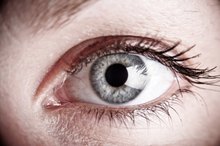What does fact checked mean?
At Healthfully, we strive to deliver objective content that is accurate and up-to-date. Our team periodically reviews articles in order to ensure content quality. The sources cited below consist of evidence from peer-reviewed journals, prominent medical organizations, academic associations, and government data.
The information contained on this site is for informational purposes only, and should not be used as a substitute for the advice of a professional health care provider. Please check with the appropriate physician regarding health questions and concerns. Although we strive to deliver accurate and up-to-date information, no guarantee to that effect is made.
Can Medication Change Hair Color?
Millions of men and women who must take prescription drugs or medicines to treat medical conditions find that their hair suddenly starts to change color, or that hair dyes that were used in the past fail to produce the same results post-medication as they did before medication 2. From fading to ending up with totally unexpected results after a dye job, the experience can be startling and a bit embarrassing. Knowledge about the connection between hair color and medicine is the key to understanding what you can and can't do with your hair when on certain medications 2.
Changes in Hair Color
Many antibiotics such as doxycycline may cause a slight fading of hair color, or cause certain portions of hair to turn a different shade 2. Thyroid medications may cause a darkening of the hair 2. Chemotherapy drugs may also affect coloring. Texture and thickness may also be affected. Discuss such possibilities with your physician so you aren't surprised by sudden changes, and discuss these changes with your hairstylist as well to determine your best course of action. Adverse drug reactions may also be caused by allergic reactions to a drug that cause changes in hair color 2.
Causes of Hair Color Change
Drugs to Prevent Hair Growth
Learn More
Some medical conditions such as heart failure, high blood pressure and pulmonary conditions that require individuals to take blood thinners or diuretics may also lead to changes in hair color 2. Hemodialysis can cause a lightening of hair in individuals treated with heptaminol because the methods by which color is deposited into cells and hair fibers is interrupted or slowed because of metabolic and biochemical changes in the body 2. This change may not only affect head hair but body hair as well as eyebrows, eyelashes, mustaches and beards 2.
Dealing with Changes
In some cases, a professional salon dye job may alleviate the problem temporarily, but many individuals find that some color dyes just don't "take." In such cases, the individual may have to be patient and wait until drug treatments have completed their course. Talk to your doctor about possible side effects and reactions to specific drugs, and discuss options with health-care providers and professional hair experts for optimal solutions 2.
Related Articles
References
- Drug Injury: Liability, Analysis and Prevention, O'Donnell, James, Lawyers & Judges Publishing Company, 2005
- Hair Finder
Writer Bio
Denise Stern is an experienced freelance writer and editor. She has written professionally for more than seven years. Stern regularly provides content for health-related and elder-care websites and has an associate and specialized business degree in health information management and technology.









